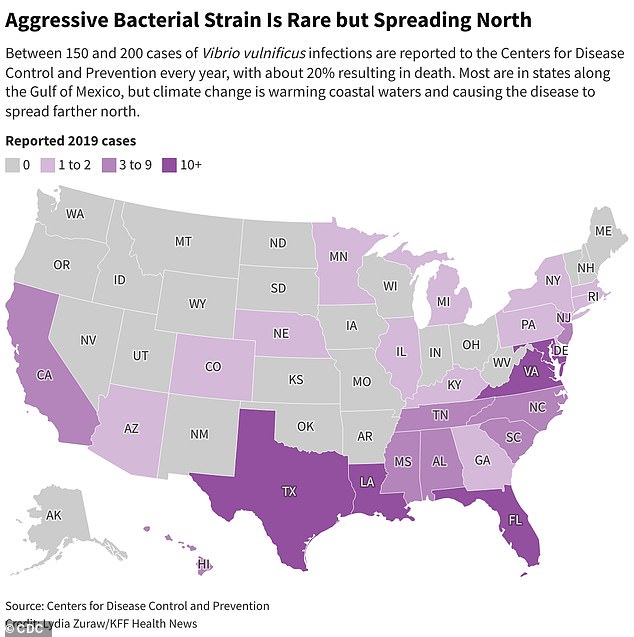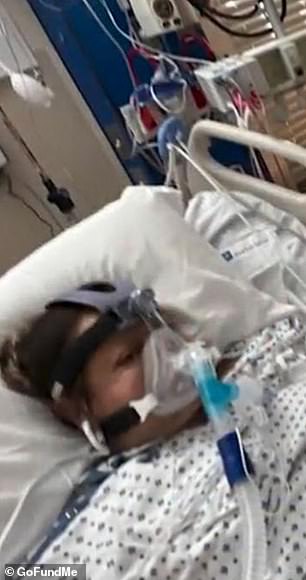‘The skin was gone, it was just bone’ Woman, 72, has her leg amputated after catching flesh-eating bacteria Vibrio vulnificus while swimming off coast of Florida
The presence of a rare flesh-eating bacteria has spread across the United States, infecting beachgoers and fish-eaters, resulting in severe infections, limb amputations and death.
Vibrio vulnificus, a bacteria that can invade open wounds and cause life-threatening infections, thrives in warm water and has been found on beaches from Florida to New Jersey and even as far north as Alaska. It can also be present in undercooked or raw seafood, such as oysters.
Debbie King of Florida suffered a cut when she boarded her friend’s boat in the Gulf of Mexico in August. While she initially thought nothing of the chafing wound, just four days later doctors amputated her leg to save her life after it became infected with Vibrio vulnificus.
Once confined to the Gulf of Mexico, Vibrio vulnificus – which thrives in warm and brackish water – has now spread to new areas due to warming ocean temperatures.

Vibrio vulnificus is beginning to spread across the United States due to warming ocean temperatures


Warning signs of a Vibrio vulnificus infection appear within hours, with patients suffering from redness and swelling around the infection site
Anyone with an open wound—even a paper cut—should avoid swimming in areas where Vibrio vulnificus has been identified to avoid exposure.
If people go swimming with cuts or scrapes, even minor ones, they run the risk of the bacteria getting into their wounds and eating away at their flesh.
In 2023, a total of nine deaths have been reported so far in Florida, New York and Connecticut, but the presence of the bacteria is spreading rapidly and scientists fear that Vibrio could reach every US coastal state by the year 2040.
A friend of Ms King (72) attended to her cut, but when she woke up the next morning, her shin was red and sore. Thinking it was just sunburn, she ignored it — until three days later when the red and blistered area grew and her doctor immediately sent her to the emergency room.
Doctors at the hospital recognized signs of the bacteria, which thrive in the body and spread very quickly, and rushed Ms King into surgery. In the waiting room, a surgeon told Ms. King’s husband that if they did not amputate her leg, she could die.
Ms. King told the Tampa Bay Times: ‘The flesh was gone; it was just bone.’

Debbie King (right) contracted Vibrio vulnificus after scraping her leg while getting into her friend’s boat in waters off the coast of Florida
While the only signs of the infection were on her shin, when doctors operated on it, they discovered it had spread, forcing them to amputate Ms King’s leg higher than initially planned. Doctors hoped they would only have to amputate at the knee, but ended up amputating from five inches above.
Four days after she scraped her leg, Ms. King lost the limb and spent four days in the intensive care unit in critical care to combat sepsis, a severe reaction to an infection in the body that leads to organ failure.
When Ms. King woke up in the hospital, her son told her that she had lost her leg, but the medication she was taking clouded her mind and she did not understand her situation at first.
It wasn’t until she was moved to a rehabilitation hospital that she took in the seriousness of what had happened to her.
She felt she had lost some of her independence and independent identity. One morning she couldn’t stop crying and said: ‘It hit me like a ton of bricks.’
Her mental status declined and several health care workers in the facility encouraged her to see a psychologist. After several sessions with one, Ms. King reframed what happened to her and began to heal emotionally, along with her physical recovery aided by physical therapy.
Ms. King eventually returned home, where she continues her therapy routine, including learning how to stand on her remaining leg and use her wheelchair.
While she says her recovery still feels like a journey, she has become more comfortable with her amputation and has even named her ‘stub’ Peg.
As she continues to progress, she says she is determined to regain even more movement and walk with a prosthetic leg.
She told the Times: ‘It’s the most horrible thing that can happen to anyone.
“But I would sit back and think, ‘God put you here for a reason – you’ve got more things to do.’
Vibrio vulnificus can also be contracted by eating contaminated raw or undercooked fish, as in the case of Laura Barajas, a 40-year-old mother from California.
After contracting the bacteria from undercooked tilapia in June, she had to have all four of her limbs amputated to save her life and spent months in hospital fighting an infection.
Her friend, Anna Messina tells News 19 Ms Barajas ‘almost lost her life’ and doctors had to put her in a medically induced coma
Ms Messina said: ‘Her fingers were black, her feet were black her bottom lip was black. She had complete sepsis and her kidneys were failing.’


Barajas, mother of a six-year-old boy, fell ill in late July days after eating the fish she bought at a local market in San Jose.
A GoFundMe page has been set up to help Ms. Barajas and her family cover medical costs and ongoing care needs. It raised more than $140,000.
Warning signs of a Vibrio vulnificus infection appear within hours, with patients suffering from redness and swelling around the infection site.
Without treatment, it can progress to necrosis – tissue death – and septicemia – a blood infection – putting patients at risk of limb amputation and death.
Prompt administration of antibiotics is essential to treat the infection.
Healthy people have a low risk of an infection, doctors said, because their immune systems are likely to be able to fight off the bacteria.
But those with weaker immune systems – such as diabetics and cancer patients – are at a much higher risk of contracting the disease.
Cases are rare, with about 150 to 200 reported each year in the US. About 30 percent of people who develop an infection from Vibrio vulnificus die from the disease, according to the Centers for Disease Control and Prevention (CDC).
